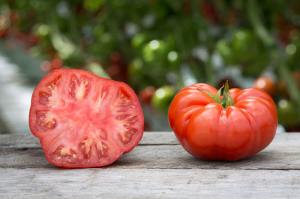Way back when I was a young child, I remember sweet vacation days spent at my grandparents’ home in Westbury. My sister and I often had “sleepover parties” with Grandma and Grandpa, whose home once was part of a tremendous potato field over by Bowling Green Elementary School. Grandpa would sit in his big chair and read the Long Island Press, while Grandma offered her pop-beads and several scarves to play “dress up” until bedtime. In the evening, we would head outside to help their dog, Pal, “do his business.” It was during these times that I would find great solace in looking at Grandpa’s beautiful garden.

(Photo courtesy of Lufa Farms/ CC BY-SA 2.0)
Grandpa grew tomatoes of every color. His favorites were orange and yellow varieties, though his Beefsteak tomatoes were heavy and full of flavor. Grandma often used the tomatoes Grandpa grew for a light sauce that she spooned over pasta in the warmer months. She referred to it as “dirty sauce.”
“Dirty sauce” was the name for this pasta topping because it appeared “dirty” and chunky, not smooth like regular marinara. The purpose was to keep the meal lighter on hot days, since air conditioning was not an option and nobody really felt like eating a heavy meal in the heat and humidity. It was quick and easy to put together and tasted like heaven.
Grandma cut the tomatoes into great chunks, sometimes removing seeds, sometimes allowing them to remain. She removed the seeds because they irritated my father’s sensitive stomach, but when she made it for us, she let those delectable bites remain. Tomatoes were placed on the side while she diced an onion and minced several cloves of garlic. It was then that she asked my sister and me to pick some basil from the garden for her.
When making the dirty sauce, basil is a huge component of the dish. This is what gives it the most flavor. My sister and I never brought in enough basil, so Grandma would often have to return to the garden to get more. She would chop it roughly and then she added some oil to a hot pan. Basil, onion and garlic hopped into the hot oil bath and were sautéed until they wilted and the air had the perfume of the beginnings of Pasta Sauce Sunday.
Tomatoes were then added to the pan, which hissed as they were cooked down quickly. No water was added, because the tomatoes lent enough moisture to allow the mixture to turn into a rough sauce.
Now, here is where it gets a little tricky. One can add a can of tomato paste to the mixture and allow it to simmer for about 30 minutes. That is how Grandma made it and it is exactly how my mom makes it as well. However, you can just leave it “as is” and spoon it over cooked pasta. Either way, it is a delicious dish that is one of my greatest memories of that special time.
The first time that I made “dirty sauce”, I wasn’t happy with the look. It really looked like what the patio looks like after a heavy rain. Basil leaves were wilted and scattered throughout the dish, while the tomatoes were cooked but looked like something that smashed on the sidewalk. I ran the entire mixture through the blender with a full can of paste and had a delicious marinara, but it was a lot of work. I tried again with a food mill, which was meant to remove the skins and the seeds. It, too, was a lot more work than was necessary.
This year, I tried to make “dirty sauce” again. I used the pearl onions that we had grown in a whiskey barrel, some fresh elephant garlic and two fistfuls of three different varieties of basil and some fresh oregano from a plant that I have grown for several years. The aroma was heavenly. I was encouraged, and grabbed several of Mom’s pumpkin-sized Beefsteaks, which she left for my husband before she went on vacation. I tore them into chunks and tossed them into the pot. When it had cooked down for a half hour, I added half a can of paste to soak up some of the liquid. I cooked it for another 20 minutes and set it aside to rest.
The result was a thoroughly delicious concoction that was light and easy on the palate. We placed it over a bed of gluten-free Paccheri, a pasta that looks like rigatoni on steroids. Scrumptious.
If you wish to make “dirty sauce,” there are really no measurements. As most Italian grandmas will state, “you have to eyeball it.” I’m not a grandma yet, but it’s the best advice that I can give you. Once you see what it looks like, you will know that you have one of the easiest, freshest tasting dishes this side of the Mississippi. And that’s a fact.
Patty Servidio is an Anton Media Group columnist.































